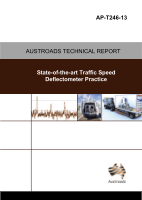Asset Management

- Publication no: AP-T246-13
- ISBN: 978-1-925037-16-6
- Published: 26 August 2013
- PDF (free) Download
This report provides a brief state-of-the-art review of current traffic speed deflectometer (TSD) practice based on information gained from attending the deflection at road traffic speed workshop held in the UK in June 2012.
The current state of deflection measurement practice in Denmark, USA, UK, Italy, Germany, Belgium and South Africa was reviewed. In the USA the Federal Highway Administration has developed the alternative rolling wheel deflectometer to assess network-level pavement strength.
Quality assurance is seen as essential for both the construction and operation of the traffic speed deflectometer. The UK has probably the most extensive experience in quality assurance where the traffic speed deflectometer is operated under contract conditions. Laser calibration is seen as an important aspect of quality assurance.
Further work to review collected traffic speed deflectometer data for its reliability and credibility can be undertaken during 2012/13 under this project.
- 1. Introduction
- 1.1. Aim
- 1.2. TSD Background
- 1.3. Methods for Measuring Surface Deflection
- 2. State-of-the-art TSD Practice
- 2.1. Summary of Current Methods of Interpreting Deflections and their Applications
- 2.1.1. Maximum Central Deflection
- 2.1.2. Deflection Bowl Shape Characteristics
- 2.2. State of Deflection Measurement
- 2.2.1. Denmark
- 2.2.2. USA
- 2.2.3. UK
- 2.2.4. Italy
- 2.2.5. South Africa
- 2.3. Quality Assurance of Measurement and Reporting
- 2.3.1. Quality Assurance (QA)
- 2.3.2. Implementation of QA in UK
- 3. Further Investigation
- 4. Summary
- 4.1. State-of-art TSD Practice
- 4.1.1. Measures of Deflection
- 4.1.2. State of Deflection Measurement
- 4.1.3. Quality Assurance of Measurement
- 4.2. Further Work
- References
- Appendix A Deflection at Road Traffic Speed (DARTS) Workshop Agenda
- A.1 Objective of Workshop
- A.2 Workshop Agenda
- Appendix B DARTS Workshop Attendees
- B.1 List of Attendees
- Appendix C DARTS Workshop Discussion and Outcomes
- C.1 Introduction
- C.2 Summary of Currently Available Systems for Measuring Deflection Response at or Close to Traffic Speed
- C.3 Summary of Current Methods of Interpreting Deflections and their Applications
- C.3.1 Central Maximum Deflection Only (i.e. Maximum Deflection, D0 )
- C.3.2 Deflection Bowl Shape Characteristics (i.e. Curvature Function, etc.)
- C.3.3 Full Deflection Bowl Shape Measurement
- C.3.4 Austroads Context
- C.4 Applications for Deflections
- C.5 Network is not Project Level – Approaches in Belgium
- C.6 How Deflection Measurements are used Presently in Denmark
- C.7 State of Deflection Measurements in Australia
- C.8 Strength Ranking of Pavement Structures
- C.9 Performance Management – including the Structure (Use of Rolling Wheel Deflectometer in the USA)
- C.10 Current UK Implementation of the TSD
- C.11 Using the TSD to Assess New Pavements (in Italy)
- C.11.1 Characteristics of the ANAS TSD
- C.11.2 Overview of TSD Performance
- C.11.3 Moveable Beam and Calibration Process
- C.11.4 Use of TSD in Management of Road Network
- C.12 Towards a Unified Pavement Design and Maintenance Approach for ‘Long-life’ Pavements (in the UK)
- C.13 Developments in TSD Systems (Denmark)
- C.14 New Nordic Performance Models
- C.15 SHRP 2 Study-development of Continuous Deflection Device
- C.16 Integration Approach to TSD Analysis (Australia)
- C.17 TRL Investigation of Factors Influencing TSD Results
- C.18 Early Trials for Rigid Pavement Assessment
- C.19 Future Plans for the DaRTS group
- Appendix D South African TSD Acceptance Testing
- D.1 General
- D.1.1 Possible FAT and SAT Tests
